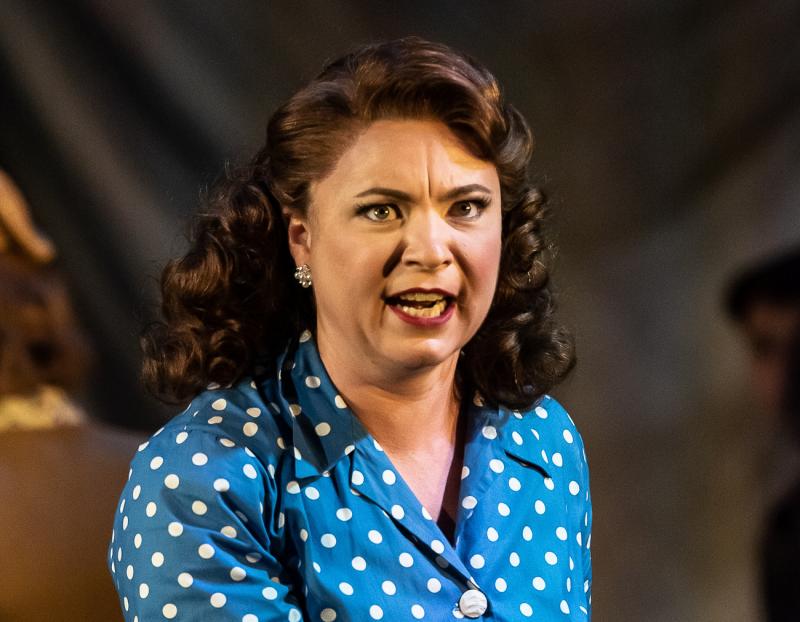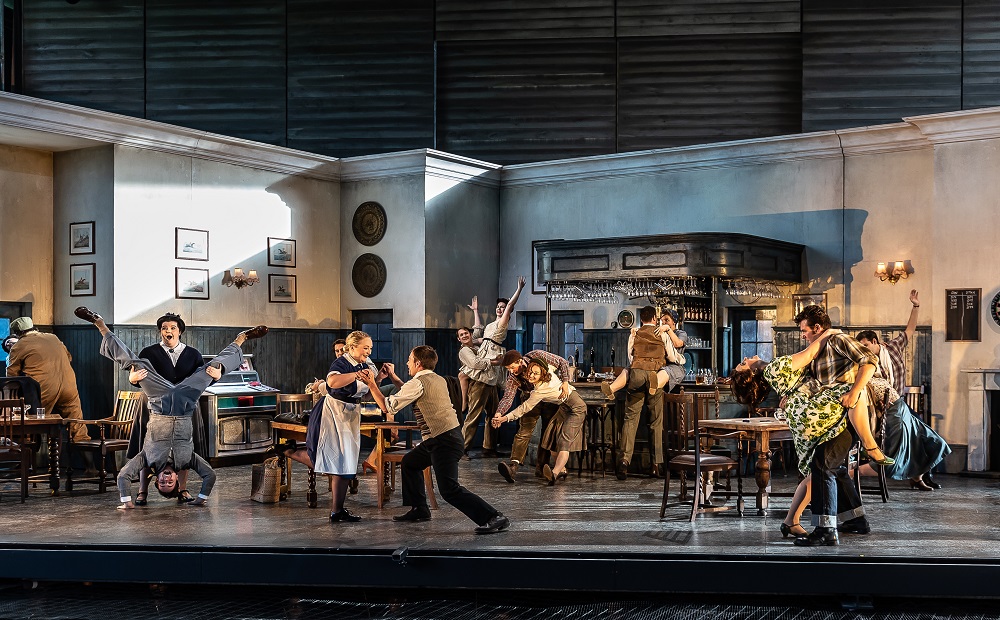The Bartered Bride, Garsington Opera review – musical glories, dramatic questions | reviews, news & interviews
The Bartered Bride, Garsington Opera review – musical glories, dramatic questions
The Bartered Bride, Garsington Opera review – musical glories, dramatic questions
Setting high operatic standards for Smetana in the idyllic Chilterns

It is a coincidence - and probably no more than that - that Garsington Opera has opened its 30th birthday season with the “founding work of modern Czech opera” in the year that also marks the 30th anniversary of the Velvet Revolution in Prague.
Musically, Bedřich Smetana’s The Bartered Bride is marvellous, vivid, dance-infused work. In the second performance of the run, conductor Jac van Steen and the Philharmonia Orchestra were achieving miracles of clarity, pacing and ensemble with it. The score is peppered with instructions to ratchet up the tempo or to pull it back, or “suivez le chant” (follow the singing), and there are always little caesuras marked which allow a breathing space before a new tempo and mood are established. Van Steen and the orchestra were not only able to give all three acts a flow which always seemed very natural, but the dances had genuine lightness and lift, plus all the swagger and menace was there when necessary, and the moments of youthful passion too. But most remarkable of all, there was more or less infallible co-ordination between pit and stage throughout, even with Garsington’s wide stage and a lot for the chorus to do. This is a remarkable company achievement and a real feather in the caps of van Steen and chorus director Jonathon Swinard. In the introductory talk, van Steen suggested the work needs to be heard at least three times in full performance to even start to unearth its treasures and subtleties; it would be impossible to argue with that.  Dramatically, all is not so simple with Bride. It has a plot which is thin and, for our times, problematic. The Czech title of the piece literally means the “sold” bride, which in itself as an idea is more likely to be a source of disquiet and alarm rather than amusement for, at least, say, half the audience. And one of the motors of the plot is the fact that one of the "suitors" of this bride, Vašek, is the object of general disdain and ridicule because he is what once would have been called a simpleton with a stammer, but these days would more likely be referred to as having an intellectual disability and also disfluency.
Dramatically, all is not so simple with Bride. It has a plot which is thin and, for our times, problematic. The Czech title of the piece literally means the “sold” bride, which in itself as an idea is more likely to be a source of disquiet and alarm rather than amusement for, at least, say, half the audience. And one of the motors of the plot is the fact that one of the "suitors" of this bride, Vašek, is the object of general disdain and ridicule because he is what once would have been called a simpleton with a stammer, but these days would more likely be referred to as having an intellectual disability and also disfluency.
Director Paul Curran has updated the action to 1950s England, which brings the little jealousies and intrigues of a village where everyone knows each other into a zone that is recognizable and familiar for the audience. Does it add to the experience? Yes. Does it solve the work’s dramatic weaknesses? No.
The production makes another bold decision which works well, however. The language is Czech throughout. It is the language in which to hear the speech rhythms and to revel in the sound the best, and all of the principal singers gave characterful and vocally strong accounts of their roles. As the bride Mařenka herself, Natalya Romaniw struck the ideal balance between the dreaming of a life with her intended husband and the scheming required to get her there. She brought real pathos and depth to the Act 3 aria "Ó, jaký žal" ("O what grief"), even though it is never less than plain that a solution to her woes is just around the corner. As Jeník, American tenor Brenden Gunnell was vocally totally persuasive, with a wonderful sound. Of the other principals, Peter Savidge gave a superbly consistent account of the bride's father Krušina, beset with constant trouble, and as the marriage broker Kecal, Joshua Bloom was vocally and dramatically convincing. The movement and dancing and vocal strength of the Garsington chorus was one of the joys of this production. The movement group which trapezed, juggled, somersaulted and cartwheeled brought joy to the dramatically strained third act.
Any doubts tend not to linger: the hint of heaven about this idyllic corner of the Chilterns on a fine summer evening, and the assuredness and professionalism of Garsington at all levels of its operation, waft them away with ease.
The future of Arts Journalism
You can stop theartsdesk.com closing!
We urgently need financing to survive. Our fundraising drive has thus far raised £49,000 but we need to reach £100,000 or we will be forced to close. Please contribute here: https://gofund.me/c3f6033d
And if you can forward this information to anyone who might assist, we’d be grateful.

Subscribe to theartsdesk.com
Thank you for continuing to read our work on theartsdesk.com. For unlimited access to every article in its entirety, including our archive of more than 15,000 pieces, we're asking for £5 per month or £40 per year. We feel it's a very good deal, and hope you do too.
To take a subscription now simply click here.
And if you're looking for that extra gift for a friend or family member, why not treat them to a theartsdesk.com gift subscription?
more Opera
 theartsdesk at Wexford Festival Opera 2025 - two strong productions, mostly fine casting, and a star is born
Four operas and an outstanding lunchtime recital in two days
theartsdesk at Wexford Festival Opera 2025 - two strong productions, mostly fine casting, and a star is born
Four operas and an outstanding lunchtime recital in two days
 The Railway Children, Glyndebourne review - right train, wrong station
Talent-loaded Mark-Anthony Turnage opera excursion heads down a mistaken track
The Railway Children, Glyndebourne review - right train, wrong station
Talent-loaded Mark-Anthony Turnage opera excursion heads down a mistaken track
 La bohème, Opera North review - still young at 32
Love and separation, ecstasy and heartbreak, in masterfully updated Puccini
La bohème, Opera North review - still young at 32
Love and separation, ecstasy and heartbreak, in masterfully updated Puccini
 Albert Herring, English National Opera review - a great comedy with depths fully realised
Britten’s delight was never made for the Coliseum, but it works on its first outing there
Albert Herring, English National Opera review - a great comedy with depths fully realised
Britten’s delight was never made for the Coliseum, but it works on its first outing there
 Carmen, English National Opera review - not quite dangerous
Hopes for Niamh O’Sullivan only partly fulfilled, though much good singing throughout
Carmen, English National Opera review - not quite dangerous
Hopes for Niamh O’Sullivan only partly fulfilled, though much good singing throughout
 Giustino, Linbury Theatre review - a stylish account of a slight opera
Gods, mortals and monsters do battle in Handel's charming drama
Giustino, Linbury Theatre review - a stylish account of a slight opera
Gods, mortals and monsters do battle in Handel's charming drama
 Susanna, Opera North review - hybrid staging of a Handel oratorio
Dance and signing complement outstanding singing in a story of virtue rewarded
Susanna, Opera North review - hybrid staging of a Handel oratorio
Dance and signing complement outstanding singing in a story of virtue rewarded
 Ariodante, Opéra Garnier, Paris review - a blast of Baroque beauty
A near-perfect night at the opera
Ariodante, Opéra Garnier, Paris review - a blast of Baroque beauty
A near-perfect night at the opera
 Cinderella/La Cenerentola, English National Opera review - the truth behind the tinsel
Appealing performances cut through hyperactive stagecraft
Cinderella/La Cenerentola, English National Opera review - the truth behind the tinsel
Appealing performances cut through hyperactive stagecraft
 Tosca, Royal Opera review - Ailyn Pérez steps in as the most vivid of divas
Jakub Hrůša’s multicoloured Puccini last night found a soprano to match
Tosca, Royal Opera review - Ailyn Pérez steps in as the most vivid of divas
Jakub Hrůša’s multicoloured Puccini last night found a soprano to match
 Tosca, Welsh National Opera review - a great company reduced to brilliance
The old warhorse made special by the basics
Tosca, Welsh National Opera review - a great company reduced to brilliance
The old warhorse made special by the basics
 BBC Proms: The Marriage of Figaro, Glyndebourne Festival review - merriment and menace
Strong Proms transfer for a robust and affecting show
BBC Proms: The Marriage of Figaro, Glyndebourne Festival review - merriment and menace
Strong Proms transfer for a robust and affecting show

Add comment